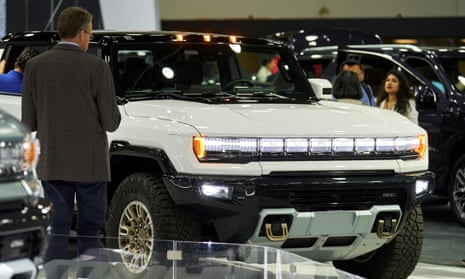
Carmakers are pushing electric SUVs, but smaller is better when it comes to EVs
Electric SUVs are better than their gas counterparts for the climate, but they can be worse than compact gas burners
The electrification of the US’s vast fleet of cars and trucks is a cornerstone of Joe Biden’s plan to tackle the climate crisis. But the ballooning size of electric vehicles, crowding out smaller, more affordable models that strip fewer resources from the environment, threatens to undercut this goal.
Last week, General Motors announced that it will axe its Chevy Bolt electric vehicle by the end of the year. The compact Bolt, launched in 2016 as a way to challenge Tesla for mainstream EV buyers, is one of the cheapest electric cars on the market, costing less than $30,000 and eligible for the $7,500 tax credit offered to drivers for EVs in last year’s mammoth Inflation Reduction Act, unlike the similar Nissan Leaf, which doesn’t qualify due to its foreign manufacture.
In a sign of how the US’s fixation upon large SUVs and pickup trucks is now infiltrating the nascent EV market, General Motors, which aims to sell 1m EVs in the US by 2025, said that the Michigan plant currently churning out Bolts will switch to new electric models of the Silverado and the GMC Sierra – hulking, and more expensive, alternatives that will probably provide the auto company a greater financial return than the modest Bolt.
But the move has underlined how threadbare EV options are for Americans, removing one of the only affordable, soberly sized options from the market at a time when the White House aims for half of all car sales to be electric by 2030, up from barely 5% today, in order to slash planet-heating emissions. The average price of an EV is still $15,000 more than the average non-luxury gas car.
Experts warn that the supersized nature of new EV models is also worse for the environment than smaller options, requiring large amounts of mined rare minerals such as lithium and cobalt for their huge batteries and using more energy to move their enormous frames around US streets.
While electric vehicles are always a better option for the climate than an exact equivalent powered by gasoline or diesel, rankings by the American Council for an Energy-Efficient Economy (ACEEE) show that the largest EVs are actually worse than more compact gas cars due to the emissions embedded in their creation. It turns out size, as well as fuel source, matters.
Beeswarm chart comparing the Green Score of vehicles by their weight class.
“There just isn’t the counterweight of smaller, more affordable electric vehicles,” said Alissa Kendall, an expert in environmental engineering at the University of California, Davis, who said she is herself “desperately” seeking an affordable EV to replace her 2012 Ford C-Max, which she is unable to find a new battery for.
“The EV market is now almost entirely dominated by large, luxury, expensive vehicles,” she said. “That isn’t really helping low-income people and those on the frontlines of polluting facilities and climate change.”
The Chevy Bolt is among the greenest cars currently available, according to ACEE rankings that gives it a “green score”, based on pollution from the manufacturing of cars and the emissions they produce, of 57. By comparison, the much-hyped electric version of Ford’s bestselling F-150 truck, a similar profile to the Silverado and Sierra that will replace the Bolt, has a score of just 47.
While the EV F-150 is still much better for the climate than its gas-guzzling original, it is leading a pack of gargantuan EVs pushed by auto companies that are significantly worse for the environment than more moderately sized alternatives.
The new electric Hummer, costing $110,000 and enthusiastically test driven by Biden himself, has a battery which alone weighs as much as a small car and contains half the amount of lithium needed to power an entire bus full of people, while the Rivian R1S, the worst-performing EV in the ACEEE’s rankings and deemed worse for the environment than a decent chunk of gas-powered cars, weighs as much as an adult African elephant.
after newsletter promotion
“It’s unfortunate the Bolt is being phased out because it was one of the more efficient electric vehicles, due to its size, and also one of the most affordable, so there is an equity issue there too,” said Peter Huether, senior research associate at the ACEEE.
Huether said larger vehicles had other drawbacks, too, such as the safety risk they pose to pedestrians and cyclists due to their unnecessarily outsized presence on city and suburban streets. “We are seeing automakers put out more of these larger EV models and we are worried in general about the rise of these larger vehicles,” he said. “It’s really whittling away at our ability to reduce emissions.”
Kendall said that it is a positive sign to see the worst-polluting large SUVs and trucks being replaced by electric versions – transportation is the largest source of emissions in the US – but that regulations and incentives were needed to help nudge the country away from simply perpetuating the trend of larger and larger vehicles on the roads. By one estimate, 78% of all vehicles sold in the US will be an SUV, truck or van by 2025.
“The challenge in the long run is providing electric mobility to the most people in a way that doesn’t involve everyone driving around huge vehicles that are bad for the planet, bad for critical minerals, bad for a lot of other reasons,” Kendall said.
“There’s a social need to think of policies to support smaller, more efficient vehicles.”